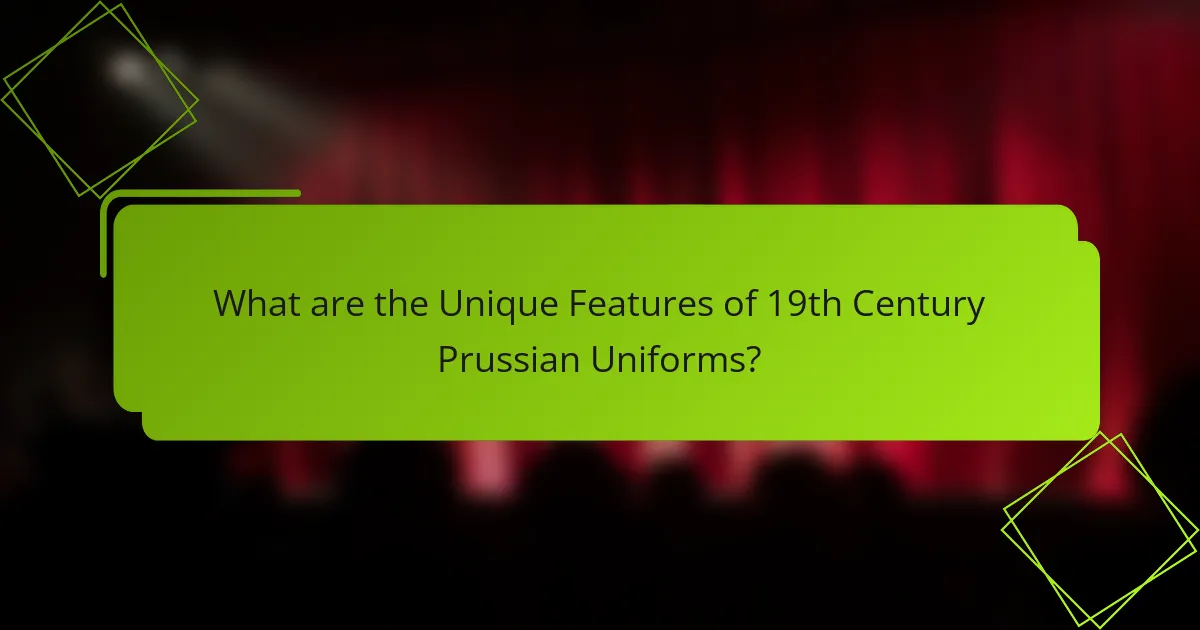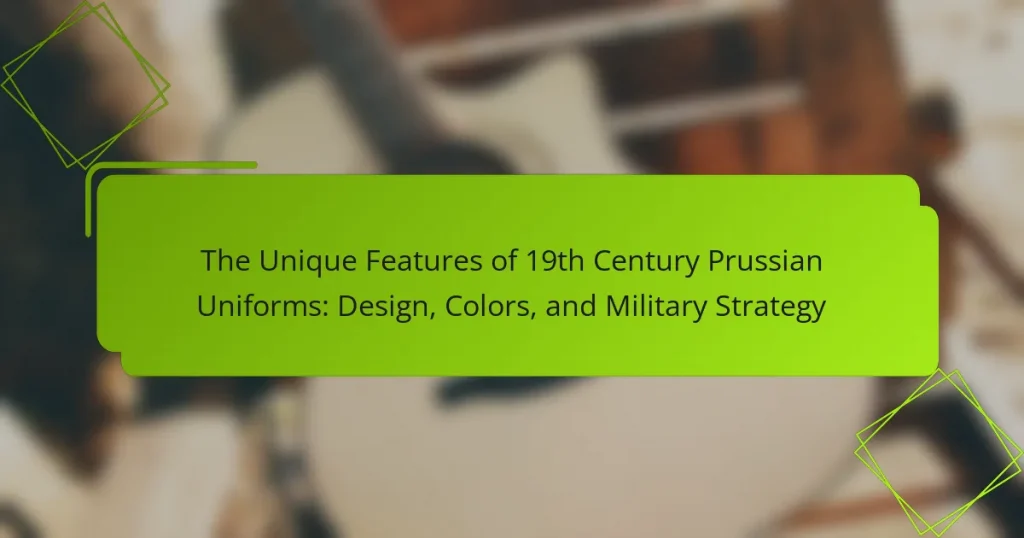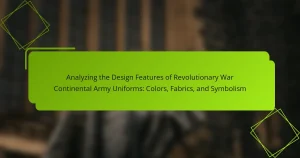The article focuses on the unique features of 19th century Prussian uniforms, highlighting their distinctive design, colors, and military symbolism. Key characteristics include the predominant dark blue color that represented the strength of the Prussian state, as well as elaborate embellishments like brass buttons and intricate piping that indicated rank and unit affiliation. The iconic pickelhaube, a spiked helmet, and tailored cuts for mobility are also discussed. Additionally, the use of durable wool fabrics and distinguishing elements such as epaulettes and sashes reflect the military efficiency and discipline of the Prussian army during this era.

What are the Unique Features of 19th Century Prussian Uniforms?
19th century Prussian uniforms are characterized by their distinctive design, colors, and military symbolism. The uniforms often featured a dark blue color, which was both practical and symbolic of the Prussian state’s strength. A notable attribute was the use of elaborate embellishments, such as brass buttons and intricate piping, which signified rank and unit. The uniforms also included the pickelhaube, a spiked helmet that became iconic during this period.
Additionally, the cut of the uniforms was tailored for mobility and ease of movement in battle. The use of wool fabrics was common, providing durability and warmth. The incorporation of epaulettes and sashes further distinguished officers from enlisted men. Overall, these features reflected the military efficiency and discipline of the Prussian army during the 19th century.
How did design elements influence the identity of Prussian uniforms?
Design elements significantly influenced the identity of Prussian uniforms by establishing a distinctive visual representation of military authority. The use of specific colors, such as dark blue and red, contributed to a recognizable aesthetic that symbolized discipline and tradition. Tailoring techniques emphasized sharp lines and fitted silhouettes, projecting an image of professionalism and order. Unique insignias and epaulettes denoted rank and unit affiliation, reinforcing hierarchy within the military structure. The adoption of the Pickelhaube helmet became a signature feature, enhancing the uniforms’ iconic status. Historical context shows that these design choices were deliberate, aiming to instill pride and unity among soldiers. Overall, the design elements of Prussian uniforms played a crucial role in shaping their identity and legacy in military history.
What specific design characteristics were prominent in these uniforms?
Prominent design characteristics of 19th century Prussian uniforms included distinct colors, structured silhouettes, and intricate detailing. The uniforms often featured a dark blue color, symbolizing military tradition. Tailored cuts emphasized a sharp, authoritative appearance. Brass buttons and epaulettes added a touch of elegance and rank distinction. The use of distinctive insignia indicated unit affiliation and rank. Additionally, the incorporation of high-collared tunics provided a formal look while enhancing soldier visibility. Overall, these design elements reflected both military discipline and national pride.
How did the design reflect the military culture of Prussia?
The design of 19th century Prussian uniforms reflected the military culture of Prussia through its emphasis on discipline and functionality. The uniforms were characterized by their structured silhouettes and tailored fits, which symbolized order and hierarchy. Colors such as dark blue and black were chosen for their association with authority and professionalism. Brass buttons and insignia were prominently displayed, signifying rank and unit affiliation. The use of epaulettes further emphasized the military hierarchy and discipline. Additionally, the practicality of the designs allowed for ease of movement during military drills and engagements. This focus on both aesthetics and utility illustrated the Prussian commitment to military excellence and preparedness.
What colors were used in 19th Century Prussian uniforms?
19th Century Prussian uniforms primarily used dark blue, white, and red colors. The dark blue served as the main color for the tunics. White was often used for trousers and detailing. Red accents were common in the form of piping and cuffs. These colors were symbolic of the Prussian military tradition. The color scheme also aimed to create a distinct identity among the troops. Historical records confirm these color choices in military documentation of the era.
What significance did color choices have in military representation?
Color choices in military representation were significant for identification and morale. Distinct colors helped differentiate units on the battlefield. For example, the Prussian army utilized dark blue uniforms, symbolizing discipline and professionalism. Bright colors were often used in ceremonial contexts to boost troop morale. Historical records indicate that color-coded uniforms became essential for command and control during engagements. The choice of color also reflected national identity and pride. Additionally, colors were strategically selected to enhance visibility or concealment based on the environment. Overall, color choices were integral to military effectiveness and representation.
How did the colors vary across different ranks and units?
Colors varied significantly across different ranks and units in 19th century Prussian uniforms. Higher-ranking officers typically wore more elaborate and colorful uniforms. For instance, generals donned bright colors such as red and gold, symbolizing their elevated status. In contrast, lower ranks often wore more subdued colors like gray or dark blue.
Infantry units commonly used dark blue uniforms, while cavalry units sported lighter shades, such as sky blue. Artillery units featured distinct colors like green to differentiate them from infantry. Each unit’s color scheme was designed to enhance visibility and distinguish roles on the battlefield.
These color variations were not only aesthetic but also strategic. They allowed for quick identification of units during combat. The specific colors also reflected the historical and cultural significance of the Prussian military.
How did military strategy shape the design of Prussian uniforms?
Military strategy significantly influenced the design of Prussian uniforms. The emphasis on discipline and organization in the Prussian military necessitated a uniform design that promoted cohesion and identification. Prussian uniforms were often characterized by their distinctive colors and cuts, which were strategically chosen to enhance visibility and recognition on the battlefield.
The use of bold colors, such as dark blue and bright red, was intended to create a strong visual presence. These colors also served practical purposes, such as camouflage in specific environments. The design included features like high collars and fitted tunics, which allowed for ease of movement and functionality during combat.
Additionally, the Prussian military adopted a more modern approach to uniform design influenced by the tactical needs of warfare. This included the incorporation of elements that facilitated quick identification of ranks and units. Historical context shows that these design choices were instrumental in the success of Prussian military campaigns during the 19th century, reflecting a well-thought-out integration of military strategy into uniform design.
What role did uniforms play in battlefield tactics?
Uniforms played a critical role in battlefield tactics by enhancing unit cohesion and identification. The distinct colors and designs of 19th century Prussian uniforms allowed soldiers to recognize their comrades quickly. This recognition was vital during chaotic engagements. Uniforms also served to intimidate opponents through their impressive appearance. The Prussian military utilized specific colors to convey rank and unit affiliation. This organization improved command and control on the battlefield. Historical accounts show that well-defined uniforms contributed to successful maneuvers and strategy execution. The use of uniforms was a tactical advantage in the 19th century military landscape.
How did the uniforms impact soldier morale and cohesion?
Uniforms significantly impacted soldier morale and cohesion. The distinct design and colors fostered a sense of unity among troops. Soldiers felt pride in wearing uniforms that represented their regiment and country. This pride enhanced their commitment to each other and their mission. Research indicates that a shared uniform can elevate group identity. Historical evidence shows that during the 19th century, Prussian soldiers reported increased morale when donning their distinctive attire. The visual uniformity also made it easier for soldiers to identify comrades in battle, reinforcing cohesion. Overall, uniforms played a crucial role in building a strong collective identity among soldiers.
What were the practical considerations in the design of these uniforms?
The practical considerations in the design of 19th century Prussian uniforms included functionality, visibility, and historical context. Functionality ensured that uniforms allowed for ease of movement and adaptability in various combat scenarios. Visibility was crucial for distinguishing soldiers on the battlefield; bright colors helped in identifying units. Historical context influenced design choices, as uniforms reflected Prussian military heritage and discipline. Additionally, materials used were selected for durability and weather resistance, ensuring soldiers remained effective under different conditions. These considerations collectively contributed to the overall effectiveness and symbolism of the uniforms in military strategy.
How did the unique features of Prussian uniforms compare to other nations?
Prussian uniforms were distinguished by their high-quality materials and innovative designs. They often featured a unique dark blue color, contrasting with the lighter colors used by many other nations. The Prussian military adopted a distinctive pickelhaube, a spiked helmet, which became an iconic symbol of their forces. In comparison, other nations like France used more traditional headgear without spikes. Prussian uniforms emphasized functionality and discipline, with tailored cuts that allowed for ease of movement. This focus on practicality was not as pronounced in the more ornamental uniforms of other countries. Additionally, Prussian uniforms included unique insignia and decorations that signified rank and unit, enhancing both organization and morale. The effectiveness of these uniforms contributed to Prussia’s military successes in the 19th century, setting a standard that influenced many other nations.
What similarities and differences can be observed in European military uniforms?
European military uniforms share similarities in structure and function but differ in design and color schemes. Many European armies adopted similar cuts and styles influenced by practicality and military tradition. Common elements include the use of tunics, trousers, and headgear. However, differences arise in the specific colors and insignia used, reflecting national identity. For instance, Prussian uniforms were often characterized by their distinctive dark blue color, while British uniforms traditionally featured red. Additionally, the use of specific embellishments and decorations varied widely, showcasing each nation’s unique military heritage. Historical context, such as the Napoleonic Wars, also influenced uniform design, leading to adaptations that emphasized national pride and military effectiveness.
How did Prussian uniforms influence military attire in other countries?
Prussian uniforms significantly influenced military attire in other countries through their innovative designs and practical features. The introduction of the pickelhaube, a spiked helmet, became a symbol of military fashion adopted by various European armies. Additionally, the use of dark blue tunics and distinctive insignia set a precedent for uniform standardization. Countries like France and Austria incorporated elements of Prussian style into their own military uniforms. The emphasis on functionality, such as the incorporation of pockets and durable fabrics, also spread to other nations. Historical military reforms in the late 19th century were often inspired by Prussian advancements, leading to widespread adoption of similar uniforms. This influence can be traced to the success of the Prussian military in conflicts like the Franco-Prussian War, which showcased the effectiveness of their uniform designs.
What lessons can be drawn from the study of 19th Century Prussian uniforms?
The study of 19th Century Prussian uniforms reveals important lessons about military strategy and identity. These uniforms were designed for functionality and visual impact. The use of bold colors and distinctive designs fostered a sense of unity among troops. Historical evidence shows that these uniforms enhanced recognition on the battlefield. They also reflected Prussia’s military reforms and modernization efforts. The emphasis on discipline and order in uniform design influenced military practices across Europe. Additionally, the study highlights the role of uniforms in shaping national identity and pride. Overall, Prussian uniforms serve as a case study in the intersection of design, strategy, and cultural representation.
How can modern military uniforms benefit from historical insights?
Modern military uniforms can benefit from historical insights by incorporating effective design elements and color schemes used in the past. Historical uniforms, such as those from the 19th century Prussian army, were designed for both functionality and psychological impact. The use of specific colors, like the iconic Prussian blue, was intended to convey authority and instill a sense of pride.
Moreover, historical insights reveal the importance of fabric durability and comfort in various climates. For instance, Prussian uniforms utilized wool for warmth and breathability. This knowledge can inform the selection of materials for contemporary uniforms to enhance soldier performance.
Additionally, studying past military strategies can guide the design of uniforms that facilitate movement and adaptability in the field. Historical examples illustrate how uniforms can be tailored to meet the demands of specific combat scenarios. Overall, modern military uniforms can evolve by integrating these historical lessons on design, functionality, and strategic effectiveness.
What best practices can be applied to contemporary uniform design?
Contemporary uniform design should prioritize functionality, comfort, and aesthetics. Functional elements include pockets, adjustable features, and breathable fabrics. Comfort is essential for wearers, ensuring ease of movement and temperature regulation. Aesthetics should reflect the identity of the organization, using colors and styles that resonate with its values. Incorporating modern technology, such as moisture-wicking materials and durability enhancements, is also recommended. Research indicates that uniforms can impact team morale and performance positively. For example, a study by the Journal of Applied Psychology found that uniforms can enhance group identity and cohesion.
The main entity of this article is the 19th century Prussian uniforms, which are defined by their distinctive design, colors, and military symbolism. The article examines the unique features of these uniforms, including their dark blue color, tailored cuts, and elaborate embellishments that signify rank and unit. It also explores how design elements influenced the identity of Prussian uniforms, the significance of color choices in military representation, and the impact of these uniforms on battlefield tactics and soldier morale. Additionally, the article highlights how the design of Prussian uniforms reflected military culture and strategy, and their influence on military attire in other countries.




